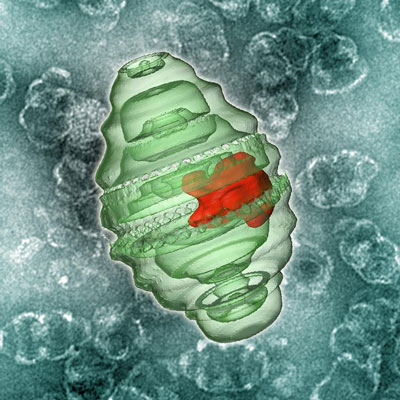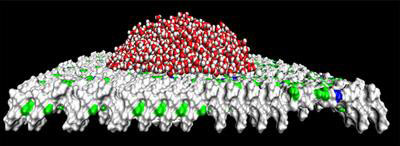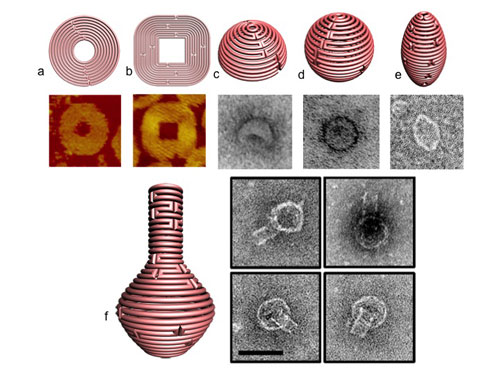Researchers at National Nanotechnology Center (NANOTEC) in Bangkok have studied the application of niosomes for encapsulation of nisin and EDTA. Nisin (Food Additive, E234) are used as antimicrobial substance in food and pharmaceutical applications.
Apr 21st, 2011
Read more
 The development of new methods that use engineered nanomaterials to transport drugs and release them directly into cells holds great potential in this area. And while several such drug-delivery systems have won approval for clinical use, they have been hampered by size limitations and ineffectiveness in accurately targeting tissues. Now, researchers at UCLA have developed a new and potentially far more effective means of targeted drug delivery using nanotechnology.
The development of new methods that use engineered nanomaterials to transport drugs and release them directly into cells holds great potential in this area. And while several such drug-delivery systems have won approval for clinical use, they have been hampered by size limitations and ineffectiveness in accurately targeting tissues. Now, researchers at UCLA have developed a new and potentially far more effective means of targeted drug delivery using nanotechnology.
Apr 21st, 2011
Read more
 Virginia Commonwealth University researchers have identified the molecular mechanisms at play for the non-additive wetting free energies at chemically heterogeneous surfaces.
Virginia Commonwealth University researchers have identified the molecular mechanisms at play for the non-additive wetting free energies at chemically heterogeneous surfaces.
Apr 21st, 2011
Read more
One of the approved Research Units deals with novel synthesis methods in chemistry, another works on "quantum diamonds".
Apr 21st, 2011
Read more
The enormous changes with respect to how we handle and consume energy and the impact on the environment are of great concern not only to us as scientists, but also to all of us as responsible citizen. Therefore, the PhD students of the International Doctorate Program NanoBioTechnology had the wish to establish a discussion with experts from relevant fields to get a deep insight into the technical, economic and social preconditions necessary for the creation of a truly sustainable energy supply system.
Apr 21st, 2011
Read more
 Miniature architectural forms - some no larger than viruses - have been constructed through a revolutionary technique known as DNA origami. Now, Hao Yan, Yan Liu and their colleagues at ASU's Biodesign Institute have expanded the capability of this method to construct arbitrary, two- and three-dimensional shapes, mimicking those commonly found in nature.
Miniature architectural forms - some no larger than viruses - have been constructed through a revolutionary technique known as DNA origami. Now, Hao Yan, Yan Liu and their colleagues at ASU's Biodesign Institute have expanded the capability of this method to construct arbitrary, two- and three-dimensional shapes, mimicking those commonly found in nature.
Apr 21st, 2011
Read more
A leading nanotechnology scientist has raised questions over a billion dollar industry by boldly claiming that there is a limit to how small nanotechnology materials can be mass produced. He says that you cannot mass produce structures with a diameter of three nanometres or less using a top-down approach.
Apr 21st, 2011
Read more
A class of engineered nanoparticles - gold-centered spheres smaller than viruses - has been shown safe when administered by two alternative routes in a mouse study led by investigators at the Stanford University School of Medicine. This marks the first step up the ladder of toxicology studies that, within a year and a half, could yield to human trials of the tiny agents for detection of colorectal and possibly other cancers.
Apr 20th, 2011
Read more
Your 6-year-old found a nail in the garage and drew pictures across the side of your new car. Gnash your teeth now, but researchers at Case Western Reserve University, U.S., say the fix-up may be cheap and easy to do yourself in the not-too-distant future. Together with partners in the USA and Switzerland, they have developed a polymer-based material that can heal itself when placed under ultraviolet light for less than a minute.
Apr 20th, 2011
Read more
The Nanodermatology Society (NDS), a physician-led organization dedicated to the scientific and medical aspects of nanotechnology and dermatology, released its first position statement on the safety of nanotechnology in sunscreens.
Apr 20th, 2011
Read more
A major discovery about an enzyme's structure has opened a window on understanding DNA repair. Scientists at Duke University Medical Center have determined the structure of a nuclease that will help scientists to understand several DNA repair pathways, a welcome development for cancer research.
Apr 20th, 2011
Read more
NANOCHANNELS aims at informing and engaging the European public on nanotechnology issues through different media channels and events.
Apr 20th, 2011
Read more
Scientists recognise how important a role electrical fields play in nature and technical areas. By adjusting these fields, the transmission of nerve impulses becomes possible and the operation of modern data storage is fulfilled by saving electrical charges (so-called Flash Memories). What researchers have not been able to do is get an ultra-precise reading of electrical fields by using physical measurement techniques. Until now, that is. With the help of one single defect centre in diamond, scientists at the University of Stuttgart in Germany successfully measured electrical fields.
Apr 20th, 2011
Read more
Scientists have reported remarkable results in developing a composite material based on graphene that is a thin as paper and ten times stronger than steel.
Apr 20th, 2011
Read more
As a follow-up of the establishment of a Memorandum of Understanding between the European Commission's Joint Research Centre, Institute for Health and Consumer Protection and the Chinese Academy of Inspection and Quarantine (CIAQ), signed in June 2010, the first Sino-EU Symposium on nanotechnology in consumer products was held on 14-15 April 2011 in Beijing.
Apr 20th, 2011
Read more
The P3SENS consortium has been formed to develop an immunoassay detection device suitable for use in emergency-medicine, whether diagnosis is required in an ambulance, emergency room or as part of a rapid near-patient laboratory test in a hospital environment.
Apr 20th, 2011
Read more




 Subscribe to our Nanotechnology News feed
Subscribe to our Nanotechnology News feed